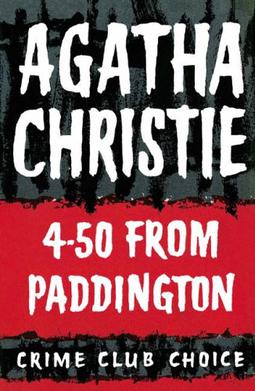Related Research Articles

Harold Thomas Gregson, known professionally as John Gregson, was an English actor of stage, television and film, with 40 credited film roles. He was best known for his crime drama and comedy roles.
David James Rees, was one of the Britain's leading golfers either side of the Second World War.

Belinda Lee was an English actress.

4.50 from Paddington is a detective fiction novel by Agatha Christie, first published in November 1957 in the United Kingdom by Collins Crime Club. This work was published in the United States at the same time as What Mrs. McGillicuddy Saw!, by Dodd, Mead. The novel was published in serial form before the book was released in each nation, and under different titles. The US edition retailed at $2.95.
Ziv Television Programs, Inc. was an American production company that specialized in productions for first-run television syndication in the 1950s.
Sonny Payne was an American jazz drummer, best known for his work with Count Basie and Harry James.
Michael Francis Gregson, known professionally as Michael Craig, is a British actor and screenwriter, known for his work in theatre, film and television both in the United Kingdom and in Australia.
Sumner Locke Elliott was an Australian novelist and playwright.

The Green Helmet is a 1961 British drama film directed by Michael Forlong starring Bill Travers, Ed Begley and Sid James. The film is centred on a British motor racing team. It is based on a 1957 novel by Australian author Jon Cleary.
Earl St. John was an American film producer in overall charge of production for The Rank Organisation at Pinewood Studios from 1950 to 1964, and was credited as executive producer on 131 films. He was known as the "Earl of Pinewood". John Davis of Rank called him "the greatest showman that The Rank Organisation has ever had, and probably the greatest showman to have lived in this country. "
Alec Coppel was an Australian-born screenwriter, novelist and playwright. He spent the majority of his career in London and Hollywood, specialising in light thrillers, mysteries and sex comedies. He is best known for the films Vertigo (1958), The Captain's Paradise (1953), Mr Denning Drives North (1951) and Obsession (1949), and the plays I Killed the Count and The Gazebo.
The One Day of the Year is a 1958 Australian play by Alan Seymour about contested attitudes to Anzac Day.

Stormy Petrel is an early Australian television drama. A period drama, the 12-episode serial told the story of William Bligh and aired in 1960 on ABC. It was the first live TV serial from the ABC.

The Astronauts is a television film, or rather a live television play, which aired in Australia during 1960 on ABC. Broadcast originally in Melbourne on 18 May 1960, a kinescope recording was made of the broadcast and shown in Sydney on 27 July 1960. FilmInk magazine said it may be the only Australian drama about the space race.
Night of the Ding-Dong is a 1954 stage play by Ralph Peterson. It was this second play, following The Square Ring. It is a comedy set in Adelaide just after the Crimean War about the locals fearing a Russian invasion. It is based on a real incident.

The Sergeant from Burralee is an Australian television play written by Phillip Grenville Mann. The play was also broadcast by the BBC and screened for West German television.
Swamp Creatures is a play by the Australian author Alan Seymour. He wrote it for radio, stage and TV. It was Seymour's first produced play.
Who Killed Kovali? is a 1960 Australian television play. It had previously been filmed for British TV in 1957.
In Writing is a 1961 Australian television play by an Australian writer living in London, Raymond Bowers, and directed by Kevin Shine.
Raymond Bowers was an Australian writer who mostly worked in London. He worked as a journalist in Perth, writing for amateur theatre. In 1954 at age 34 he went to London in order to improve his chances of having his work done professionally. His breakthrough play was In Writing in 1956, later done for Australian television. "My first aim is to make money," he said in 1957. "To do that you have to entertain. If I have any philosophising to do, I'll leave it until I'm well established."
References
- ↑ "All their hopes go down the mine". The Australian Women's Weekly . Vol. 25, no. 8. Australia. 7 August 1957. p. 4. Retrieved 9 August 2020– via National Library of Australia.
- ↑ Review of play at Variety
- ↑ It's The Geography That Counts Date: Thursday, June 13, 1957 Publication: The Times (London, England) Issue: 53866 p5
- ↑ "London's West End Season". Variety. 7 August 1957. p. 61.
- ↑ "Playwrights Succeed in London". The Age. 15 July 1957. p. 10.
- ↑ "Commercial Radio Flays". ABC Weekly. Vol. 20, no. 15. 9 April 1958. p. 14.
- ↑ Listen James at Bristol Uni
- ↑ Listen James at IMDb
- ↑ Revival of a Crime Puzzle Date: Monday, July 24, 1961 Publication: The Times (London, England) Issue: 55141 p 7
- ↑ "TV Guide". The Age. 27 October 1960. p. 39.
- ↑ "TV Guide". The Age. 2 November 1960. p. 5.
- ↑ "Clues Hidden in "Whodunnit" Dialogue". The Age. 27 October 1960. p. 31.
- ↑ "Untitled". The Age. 27 June 1961. p. 12.